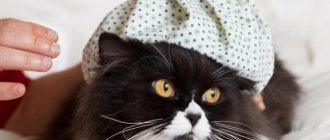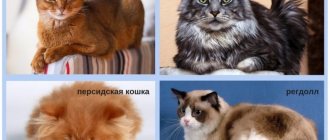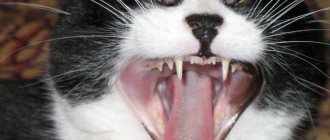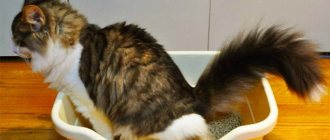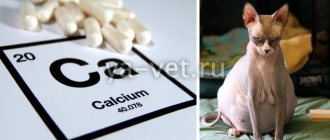The cat's skull has a rounded shape and relatively equal development of the facial and brain regions. The bones of the brain are much larger than the bones of the facial part of the skull. This feature makes the cat different from other animals.
Dental formula:
- R - Cutters
- C – Fangs
- P - Premolars
- M – Molars
Permanent teeth (30 in total):
- Upper jaw: 6 incisors, 2 canines, 6 premolars, 2 molars.
- Lower jaw: 6 incisors, 2 canines, 4 premolars, 2 molars.
The correct bite is a straight pincer bite.
Odontoclastic resorptive lesions of teeth in cats (FORLs)
Odontoclastic resorptive lesion is not carious destruction. Defects are often replaced by hyperplastic gums, dental deposits (tartar, soft plaque), and pulp tissue.
There are types 1 and 2:
- Type 1 – destruction that does not lead to the replacement of destroyed roots with bone tissue. The radiography clearly shows the roots and periodontal ligament.
- Type 2 – destruction, leading to the replacement of destroyed roots with bone tissue. On radiography there are no clear boundaries of the root or it may not exist at all; the periodontal ligament is not visualized.
Pathology such as resorption is common in cats. The reason why this disease occurs is not known; there are many theories, but none of them have been proven.
The first stage of damage is a cement defect, odontoclasts destroy enamel and dentin, and a resorptive cavity is formed. The pulp chamber is exposed, high sensitivity and pain appear, the crown often breaks, and the roots remain in the alveolus. Bleeding gums appear, because... sharp edges of the enamel constantly injure the mucous membrane. The formation of mineralized plaque on the surface is common.
Clinically, interest in food is manifested, but it is painful to take food, bleeding gums in the area of the affected teeth, a lack of integrity of the crown can often be observed, the affected part of the crown is replaced by gums or dental deposits.
To make a diagnosis, an examination of the oral cavity by a specialist and radiography is sufficient.
Resorptive teeth are a source of infection, so the only adequate treatment is complete extraction, i.e. removal and careful curettage of the hole.
Often the disease progresses and parallel teeth are susceptible to destruction.
Good to know
- Concentration of vitamins in serum in dogs and cats with diseases of the gastrointestinal tract
- Coronavirus enteritis in cats
- Coronavirus enteritis of dogs (etiology, signs, diagnosis and treatment)
- Feline infectious peritonitis - FIP
- Infusion therapy for cats and dogs for diseases of the gastrointestinal tract
- Foreign bodies of the esophagus in cats and dogs
- Campylobacteriosis of dogs and cats (Campylobacter jejuni)
- Abdominal carcinomatosis in cats and dogs
- Enemas and laxatives for cats and dogs
- Clostridia in dogs and cats
- Coccidiosis in cats and dogs
- Constipation in dogs and cats
- Cricopharyngeal dysfunction (achalasia) in dogs and cats
- Volvulus of the mesentery and intestines in cats and dogs
- Cryptosporidiosis in dogs and cats (etiology, symptoms, diagnosis, treatment)
- Roundworms (roundworms) in cats and dogs
- Infiltrative diseases of the stomach in dogs and cats (neoplasia)
Chronic gingivostomatitis (caudal stomatitis) in cats
Gingivostomatitis is an inflammation of the gum tissue and oral mucosa. In the chronic course, ulcers are formed, the affected areas are most often the gums, the mucous membrane of the cheek and palate, the larynx, the mucous membranes of the posterior surface of the oral cavity, the area of the palatoglossal arch and tongue.
The etiology of caudal stomatitis has not been established.
It is believed that the development of gingivostomatitis may be influenced by:
- Calcivirus (common).
- Immunodeficiency and leukemia (less common).
- Bartonella henselae (less common).
- The intensity of the inflammatory response to bacterial plaque (most often).
Clinical manifestations of the disease are unpleasant odor from the mouth (halitosis), swallowing disorder (dysphagia), refusal to eat, lack of appetite, increased salivation (hypersalivation).
To make a diagnosis it is necessary:
1. Rule out viral infections.
2. Visual examination of the animal.
3. X-ray according to indications.
4. Tissue biopsy according to indications.
Indications for which radiography or tissue biopsy are necessary are suspicion of a neoplasm.
The goal of treatment is to eliminate the causes of inflammation; more often, conservative (drug) treatment does not produce any results, therefore, in animals with caudal stomatitis, it is recommended to remove all premolars and molars; canines and incisors can be left if the inflammation of the gums has not spread. If the inflammation has spread, it is recommended to remove the entire arcade of teeth (upper and lower); radiography after complete extraction is necessary for control; if the removal is not done well, stomatitis will remain against the background of root fragments. As a rule, this gives positive dynamics in the treatment of this pathology.
If the owners refuse radical measures, you can try sanitation of the oral cavity (ultrasonic cleaning, polishing) in combination with drug treatment, there is a positive trend, but not significant, often such treatment is temporary, while taking or stopping taking antibacterial drugs there are risks of relapse big enough.
Forms of the disease and causes of its occurrence
Gingivitis occurs in two forms: - dental; - plasmacytic-lymphocytic form, in which the disease, if not treated, turns into chronic gingivitis.
The causes of dental disease are: - tartar; - mechanical damage to the gums; - lack of vitamins A and C; - presence of malocclusion; — age factor; - Taking drugs that lower the immune system for animals.
When hard deposits of food debris and bacterial formations form on the enamel of a cat's teeth, the owner of the animal needs to begin treatment for the pet. You need to visit a veterinarian to remove plaque from your cat's teeth, otherwise multiple microorganisms collecting on the plaque will cause it to harden (tartar), and at least an inflammatory process in the gums.
Tartars are yellow in color and are located at the base of the teeth. This leads to injury to the gums with the development of subsequent inflammation. Gums are also injured when a cat eats tubular, fish bones or other low-quality solid food. The bone can get stuck in the gum, causing an infection that penetrates the mucous membrane, spreads there and causes severe inflammation of the gum.
But where does this disease appear in pets who have excellent teeth, devoid of any plaque? Such cats eat only high-quality canned cat food or, in general, raw meat. In this case, good quality, but unbalanced nutrition can lead to a lack of vitamins in the animal, which can cause an imbalance in the microflora of the oral cavity and transfer it from the conditionally pathogenic stage to the pathogenic one.
The cat's body is also subject to age-related changes. Animals, like humans, change from baby teeth to permanent teeth. Replacing teeth is a difficult process, especially for the immune system. During this time, your cat may experience mild gingivitis. The disease also occurs during a period when a cat is treated for a long time with medications that reduce the animal’s immunity.
Gingivitis or plasmacytic lymphocytic stomatitis causes severe pain in the mouth due to ulcers on the soft tissues. It belongs to a type of autoimmune disease. This is when the cells and tissues in the body are destroyed by the body's own immune system.
Lymphocytic gingivitis can affect both the gums and the entire mucous membrane of the cat’s mouth. Ulcers appear in the mouth, mainly in the cheek area. Viral herpes, rhinotracheitis and calcivirosis provoke the development of such inflammation. A pet suffering from this disease does not eat well, which contributes to weight loss.
The reasons leading to the appearance of this disease are not yet fully understood. There are many assumptions that they are the cat breed and viruses. To date, there is no accurate data indicating all the possible causes of this disease.
Eosinophilic granuloma in cats
Eosinophilic granuloma is a series of pathologies united by a common etiology and is characterized by specific formations and inflammation of the skin and mucous membrane. The etiology of the disease has not been studied.
The accumulation of eosinophilic cells suggests that pathological changes are due to immune-mediated or allergic reactions (local or systemic).
There are several clinical syndromes:
- Eosinophilic (indolent) ulcer - the most common of all syndromes, reddish-brown lesions on the upper lip, philtrum, upper canine area, upper lip; damage may be unilateral or bilateral.
- Linear granulomas - true granulomas, lesions can be single or multiple, linear in shape, limited pink-yellow plaques or ulcers. Localized in the area of the lips, gums, tongue, palate.
- Collagenolytic granulomas are common in cats and appear as a swollen, hard lip of the lower jaw.
To make a diagnosis, it is necessary to undergo a general blood test, assess allergic reactions, tissue biopsy according to indications, and a visual examination by a specialist.
Treatment of eosinophilic granulomas must begin with identifying the cause (what is the nature of the eosinophilic granuloma), then antibiotic therapy, immunomodulatory drugs (corticosteroids, cyclosporine). In the oral cavity, granuloma often has the appearance of ulcers; with a prolonged course of the disease, severe cases of periodontal destruction together with bone tissue are possible.
Causes of stomatitis in cats
Symptoms and treatments for stomatitis in cats depend on its cause. With the secondary type, recovery occurs later, since in fact you have to fight not one, but several diseases at the same time.
Primary type
Primary causes include any mechanical trauma, thermal burns and exposure to aggressive chemicals. A pet can damage the mucous membrane with a sharp bone, bite its cheek, get burned by too hot food, be poisoned by a poisonous plant or medicinal ointment.
Secondary type
Secondary causes include infections of various etiologies, hormonal imbalances (diabetes mellitus), diseases of internal organs (liver, kidneys and other gastrointestinal organs), advanced forms of tartar and caries, allergic reactions and autoimmune disorders. The last reason is the most dangerous.
Autoimmune stomatitis in cats is expressed in an inadequate reaction of the body to its own teeth. Immune cells try to destroy them, causing inflammation at the base of each tooth. The only way to treat this pathology is to remove the entire dentition.
Animals at risk
The risk group includes kittens, elderly, lactating, pregnant animals and animals weakened by chronic diseases. What they all have in common is a weak immune system that is unable to fight infection that penetrates the wounds.
Stomatitis in a kitten is always more severe than in adult pets. It is especially difficult for British Shorthairs to tolerate it.
Cat Oral Diseases
An adult cat has 30 permanent teeth, while small kittens have 26 temporary teeth.
The change of teeth begins at the age of 3-4 months, and may be accompanied by inflammation of the gums and a strong odor from the oral cavity. During this period, it is important to observe how the teeth change, so that the change occurs completely and to prevent teeth from breaking off, as this can lead to infection of the buds of permanent teeth and their injury, improper growth and subsequently to serious problems in the oral cavity.
Cats, like other animals, can have dental problems, which owners can only find out about when the disease is already advanced or directly at a preventive appointment with a dentist. Why is it so important to pay attention to the condition of your teeth? The oral cavity is part of the gastrointestinal tract. It is from the oral cavity that digestion begins. The teeth crush the food, the saliva moistens and processes the food, facilitating the movement of food through the esophagus into the stomach.
In case of diseases of the oral cavity, a large number of microorganisms and bacteria enter the esophagus along with food, which spread throughout the body, causing harm to it. It is important to take care of your pet's oral cavity.
The most common oral pathologies in cats are:
- periodontitis and gingivitis
- feline odontoclastic resorptive lesions (FORLs)
- Feline chronic gingivostomatitis (FCGS)
Periodontopathy
Periodontopathy is the most common inflammatory disease of the oral cavity in cats, caused by the accumulation of plaque on the teeth, gums and gingival sulcus. The disease affects the majority (80-90%) of cats over 2 years of age, especially when there is no daily oral care, normal nutrition and professional preventive treatment (which means visiting a specialist veterinary dentist at least once a year). May present as juvenile hyperplastic gingivitis.
It is observed in some young purebred cats (Abyssinian and Persian), as well as in kittens of other breeds. Early juvenile gingivitis is a nonproliferative gingivitis observed in primary and permanent teeth in Persian kittens. Juvenile gingivitis-periodontitis is observed in purebred kittens such as Maine Coons and Siamese cats.
Thick deposits of plaque and tartar appear, which leads to hyperemia and swelling of the gums.
Gingivitis progresses rapidly, leading to irreversible destruction, loss of gum attachment, deep periodontal pockets, and loss of bone tissue. Due to these pathologies, cats often lose teeth at an early age.
Odontoclastic resorptive lesions
Odontoclastic resorptive lesions can be found in 25-75% of cats, most often in older cats.
Clinical and radiographic examinations of cats with periodontal disease may reveal the presence of resorptive lesions of cementum/dentine and enamel, often covered by inflammatory gingival tissue or granulation tissue. These types of lesions are called odontoclastic resorptive lesions.
This pathology can only be identified with the help of high-quality x-rays, which are required to determine the classification of the stage of the lesion.
Chronic gingivostomatitis
Feline chronic gingivostomatitis (FCGS), also known as lymphocytic-plasmacytic gingivostomatitis or caudal stomatitis, most often affects cats aged 7-8 years, but can appear as early as 4 months of age.
Chronic gingivostomatitis is the result of an inadequate immune response to oral antigenic stimulation, and unfortunately, there may be one or more initiating causes that cause this pathology. Plaque bacteria, even in very small quantities, stimulate the immune system.
When stomatitis extends to the alveolar and buccal mucosa, it is defined as alveolar or rostral stomatitis. When inflammation occurs in the caudal portion of the oropharynx lateral to the palatoglossal arch, it is identified as caudal mucositis or stomatitis.
During the evaluation, it is clinically important to know the immunological status (i.e. FeLV or FIV positive/negative) of the cat, as this may influence the choice of treatment strategy.
In addition to the listed diseases, you need to remember that there are many pathologies of the oral cavity, these can be various injuries, fractures, cleft palates (both congenital and acquired), as well as carious lesions of the teeth, fractures of the roots of teeth / crowns (complicated and uncomplicated) , pulpitis and so on.




